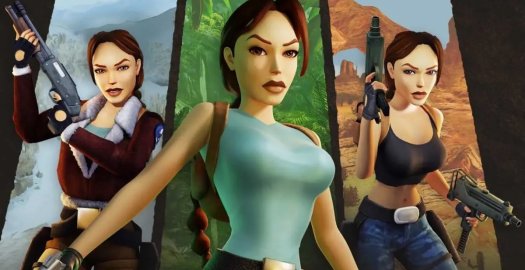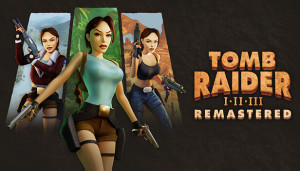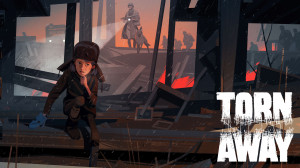Remastered vs Survivor: Tomb Raider’s Timeless Tug

Tomb Raider has unexpectedly become one of the biggest franchises of 2024, despite almost six years having passed since the last game. It’s the result of Tomb Raider I – III getting a shiny new remaster, reminding gamers of the intricate level design and precise mechanics that made the series so loved in the late 1990s. These games have plenty of the hallmarks of point-and-click adventures, too, in their complex puzzling and varied worlds. Yet, even with a shiny new aesthetic to make the great gameplay feel more accessible, it’s never immersive enough. Only Tomb Raider’s most criticised instalment has given gamers a look at a 21st century take on Lara Croft.
There’s plenty of ingenious level design to enjoy in the original games, and that’s evident even from the first instalment from 1996. St. Francis’ Folly is undoubtedly the apex of the original, an enormous tower with various offshoots dedicated to different ancient figures. These rooms contain distinct, inventive challenges to master that cleverly reflect their namesakes. There’s a sense of playfulness from the developers, Core Design, that allows such levels to sit comfortably in the adventure pantheon. It elevates the game far above killing animals and avoiding boulders which, whilst part of the varied Tomb Raider package, can make playing seem repetitive at times.
It’s Tomb Raider II (1997), however, that cemented the series’ traditions. One of its major features was introducing more story, peppering a greater number of cutscenes throughout and taking Lara into a world outside of dusty ruins. This wider scope allows for much more to happen in gameplay terms, too, whether it’s Lara escaping a submarine, speeding down the Venetian waterways, or traversing a villain-filled oil rig. There’s similarly a much more consistent sense of adventure than seen in the first game, and this makes proceeding through the levels a more thrilling experience.

The problem is, though, that no matter how aesthetically different the levels are, or how clever the puzzles, all of the PlayStation era instalments are built on the same foundations. Central to this is the grid-based movement, where the world doesn’t fit together organically but is instead shaped around Lara’s runs and leaps. There are plenty of imaginative, surprising, and often-satisfying puzzles in every single one of Core Design’s pre-PS2 games. However, it gets wearying when you beat one lengthy, knotty level, only to be rudely dumped into another brainteaser set to take another couple of hours.
There is similarly too little story to match the average 15 to 20 hours of gameplay, and so, of the first five releases, it’s the widely maligned Tomb Raider: Chronicles that comes off particularly well in retrospect. It mightn’t bring much new to the very familiar formula, one that had become a little predictable after five years and four previous instalments. Critics were as wearied as I was by the unchanging core gameplay. However, it’s actually quite a moreish experience thanks to being divided up into four short adventures. It’s not like Tomb Raider ended up with more emotional depth as a result, but pushing through a short story in a couple of hours feels the right level of effort for chasing a plot device.
From this perspective it might seem like the franchise’s current custodians, Crystal Dynamics, have pushed Lara onto a more sustainable path. The games from the 2013 reboot onwards, retroactively dubbed the Survivor Trilogy, dialled back on relentless gameplay and peppered the games with lore. Indeed, whereas the original titles have standalone stories like forebears Indiana Jones or James Bond, the most recent trilogy has an overarching narrative. An overarching story would be perfect if it could give the game a pulpy zest, but instead the story fixates on Lara’s quest to find herself and grapple with her father’s death. It feels absurd for a game with the supernatural and over-the-top set-pieces to constantly be stuck in sombre navel-gazing.

A particular low point is Shadow of the Tomb Raider (2018), in which the hamfisted attempts at narrative utterly undermine the game’s atmosphere. It’s tedious as ever when picking up scraps of letters to learn about the lore, a feature in its preceding two titles made worse here by only Lara voicing them. Most significantly, though, is the use of NPC-filled hub worlds for the first time, but unfortunately this simply adds to the game’s irksome self-seriousness. It’s not an opportunity to encounter unique, memorable individuals, but to instead talk inanely with a bunch of near-identical cutouts. The game never lets itself loose, overly conscious about appearing both cinematic and culturally aware. It could have been both of those things as the much more pulpy, enjoyable and, by the same token, emotionally engaging Uncharted titles are.
Whilst Uncharted’s fun, engaging, set-piece heavy approach is successful, Tomb Raider is historically about adventuring – and the Survivor Trilogy never quite allows players to feel like they’re doing that. So much of the trilogy is about hoovering up collectibles or following straightforward paths, conscious of making sure that the games are accessible to a mass audience. Shadow tries to improve the balance, but its array of options just makes the game feel unnecessarily cluttered.
The survival of Tomb Raider should not rest on simply going back to the late 90s. The original games are great, but are undoubtedly not a perfect formula given how tiresome they became for critics a few releases in. From the perspective of today, where the series has hit a standstill, it appears the generally thought worst instalment provides a better template for how to move Tomb Raider forwards. The Angel of Darkness (2003) is a buggy, incomplete, and sometimes unsatisfying title, yet it is more compelling than most of its better-rated siblings.

Ever since The Angel of Darkness flopped it seems like Tomb Raider has been in damage control mode, its creators endeavoring to ape the mainstream in a desperate attempt to remain relevant. Indeed, its original publisher dropped original developers Core Design following that game, installing Crystal Dynamics for every mainline release after. The Angel of Darkness was not one of the safe crowd-pleasers Tomb Raider is latterly known for but an attempt to improve on the series’ familiar mechanics. It was, though, an attempt too ambitious given the pressure to get the game on the shelves. RPG elements and the second playable character’s unique moveset were largely jettisoned, leaving only a couple new moves for Lara and slightly floaty controls. The end result was a flop manufactured by the pressures of its industry.
Much of the criticism levied at the title was around the unwieldiness and frequent bugs, yet in 2024 PC players can enjoy a fan-made Restoration Project that better shows the game’s promise. Many of the environments and puzzles are now fun to confront thanks to a friendlier camera, tighter movement, and fixes that even include fairer boss fights. The smoother experience gives room to appreciate how multi-dimensional and alive the environments are, something little found in the predictable earlier games and definitely not in its checklist-heavy successors. Some of the control issues still remain after patching, and several levels are fundamentally incomplete, yet the journey feels overall like gaining a glimpse of Tomb Raider’s possible future.
One of the elements that makes the game surprisingly moreish is its approach to the story. Dialogue trees are one of the most intriguing new additions, and in a less rushed, NPC-populated title they would do a great job at making Lara’s world immersive. Most importantly, though, the story threads its way throughout the adventure, with an interesting array of villains, supporting characters, and plot twists serving to expand Tomb Raider beyond its puzzle-platformer origins. In an ideal world where The Angel of Darkness was a better managed project it would have perfectly married the series’ origins with the propulsion of a cinematic, suitably pulpy narrative. The Angel of Darkness was probably the last time Lara’s adventures were truly fun and surprising.

People involved in the game did pour love into it, and that’s resulted in a dedicated fanbase which feels more alive than ever today. It was the first title in the series to have a score performed by a symphonic orchestra, giving the blockbuster storytelling an epic feel unmatched by the visually bigger-scale later titles. Its writer, Murti Schofield, was particularly invested in the world and had plans for an unfortunately now-scrapped trilogy. His investment in the lore he created is such that he’s even read and openly celebrated the full-length, entirely fan made novelization – which is part of a series still being put together. No other games in the franchise have such extensive, highly publicised fan fiction written in their honour, a reflection of the quality found beneath The Angel of Darkness’ superficial failings.
Tomb Raider is today simply not as exciting or involving as it has the potential to be. It’s time that the brand’s owners stopped making kneejerk attempts to try and fit the current vogue, the series being rebooted and retooled with each new console generation. If it’s to not just fall in line with the countless big budget action adventures around, then it needs to take risks once again, and not fear the failure of The Angel of Darkness. If commercial interests are the guiding force for Tomb Raider today, then the remasters show that gamers want the brand to mean excitement, challenge, and originality like it once did.







![[I] doesn’t exist - Game Review](https://cdn.nivoli.com/adventuregamers/images/screenshots/47338/header__medium.jpg)



,_con_logo__medium.png)




